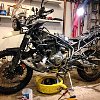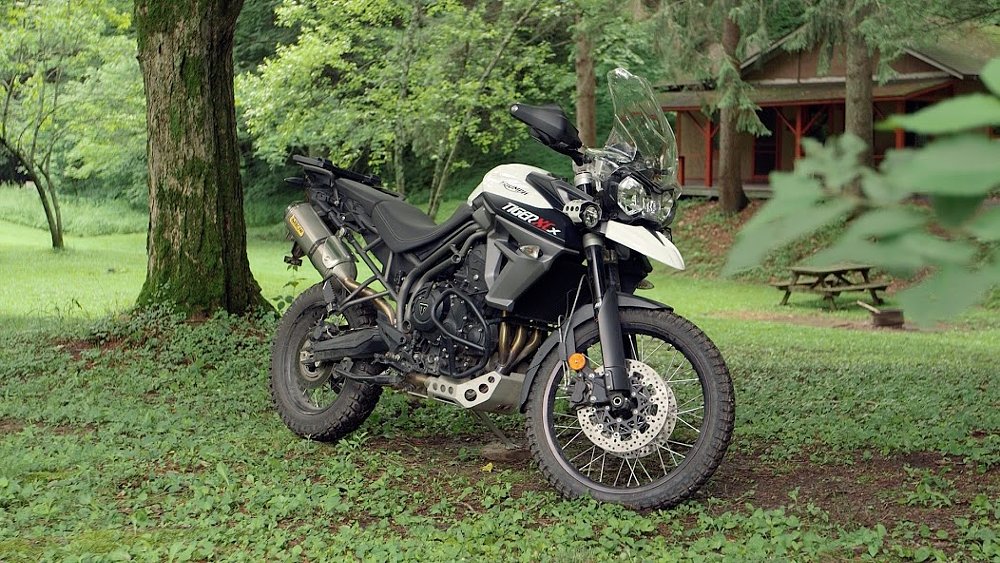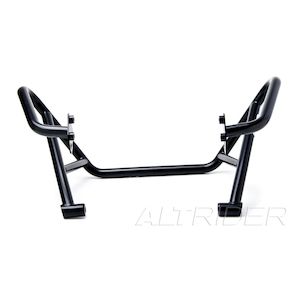A little over a year ago, Triumph gave RevZilla a 2015 Tiger 800 XCx from its press fleet for a long-term review. That bike no longer belongs to Triumph. It is currently sitting in my garage with roughly 16,000 miles on the odometer.
Let me explain.
As the new guys in the business, and being located on the East Coast, far from the manufacturers' press fleets in Southern California, it's a little more complicated for us to get our hands on new motorcycles for testing. The Tiger was actually the first long-term press bike we got here at ZLA HQ in Philadelphia. When we were finished with it, Triumph told us the bike could be dropped off at a local dealer, where it would be sold as a demo unit. I saved them a step and pulled out my checkbook — which is a pretty telling review in itself.
Having parted ways with my 1999 Honda VFR800, I had been looking for an ADV bike to fill the space in my garage. The Tiger fit my needs nicely as it is skewed toward the on-road crowd. What I didn’t anticipate was how much I would enjoy learning to handle this big bike off-road.

The roads traveled
When the XCx initially showed up from Triumph it had just over 3,000 miles on the odometer. Throughout the past year, I've logged over 13,000 additional miles, riding the Tiger down a myriad of different roads.

As a touring machine, it took me to Nashville to attend my best friend's wedding. I traveled through the mountains of Tennessee, North Carolina, and Virginia, covering 2,400 miles over five days. It has been my daily commuter through the bombed-out, pothole-laden streets of Philadelphia. With TKC80s installed, I attended the Pine Barrens Adventure Camp riding school before heading off to AltRider’s “Conserve the Ride” event. Two weeks after that, I ended up in Canada, competing in a 500-mile off-road endurance race with my friend, and fellow Tiger owner, Steve Kamrad. In short, over the past year, I have tested this bike in as wide a variety of situations as any Tiger owner is likely to attempt.
How it performed
What I have learned is the Tiger is truly a compromise between two worlds. On the street, the Tiger proves to be a comfortable touring machine, a "grocery getter" on the way home from the office, and a backroad burner on the weekend with friends. With the addition of a set of panniers and a top box, I have ample storage for pretty much everything short of the kitchen sink. There is plenty of power on tap for two-up riding and it became my bike of choice for hauling passengers around the city, as well as on longer rides.
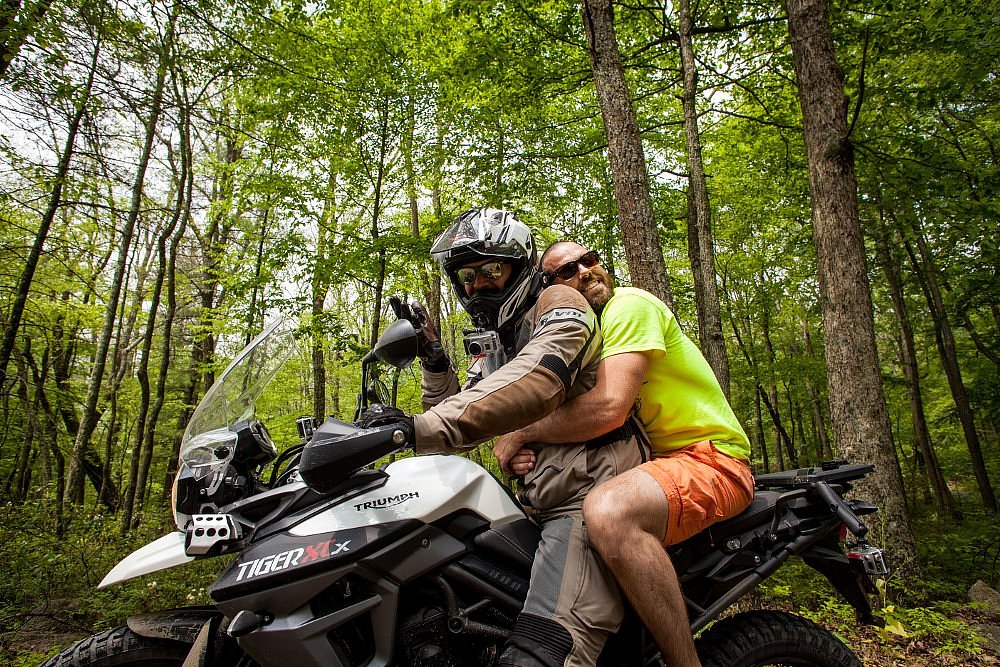
Electronic cruise control, heated grips, a slightly taller windscreen, and a comfort gel seat make 500-mile days almost too easy. (The farthest I ever rode this bike in a 24-hour period was 800 miles, so I have yet to tackle an Iron Butt ride with it.) The WP suspension soaks up the bumps and bruises of the beaten roads here in the Northeast, providing a damn comfortable ride.

Throughout the year, I learned the most about the suspension. I just assumed that because of the large amount of travel there would be certain compromises I would have to make. The downside being, with all of that travel, the bike tends to wallow a bit if you push it too hard through the corners. Over time, I’ve learned that the WP suspension on this bike is sprung a bit too soft for a rider of my size. While being able to adjust for compression and rebound damping helps (as well as preload and rebound adjustments on the rear shock), I am considering having some work done to better accommodate my 205 pounds.
I had a problem with the stock brake pads on the rear of the bike. The material on the outer pad separated from the backing under severe braking around 6,000 miles and gouged a decent gash into my rotor. I was able to sand it down and replace the pads with a set of EBCs, but it was a bit unnerving.
I spend nearly all of my time riding in “Sport” mode, even in off-road situations. I don’t think I have used “Rain” mode once in the past year. I would love the ability to fine-tune this a little bit with some sort of aftermarket programmer. While Triumph has done a great job tuning smooth throttle response, I wouldn't mind being able to experiment with a bit more "snap" in sport mode.

Off-road, the bike is competent, but it’s still a big, heavy machine and requires muscle in certain situations to get it to do what you want. I love the folks who argue that these middleweight ADV bikes have no place off-road. After spending the past year riding with others on Tigers, BMW F 800s, and Africa Twins, I can promise you that there is plenty of off-road riding you can do with these bigger bikes. I will say that taking some sort of off-road riding training goes a long way toward understanding how to best control these bigger bikes versus smaller dual-sport machines.
When it comes to off-road riding, I abandon the "pre-programmed" rider modes, opting instead for a custom combination of settings. As I mentioned earlier, I leave the throttle map in “Sport” mode all the time, even when riding in the dirt. The ABS is set to "Off-road" which means it remains engaged at the front wheel and is shut off at the rear. I prefer to disable the traction control completely, forgoing the “Off-road” setting, which only allows for limited wheel slip.
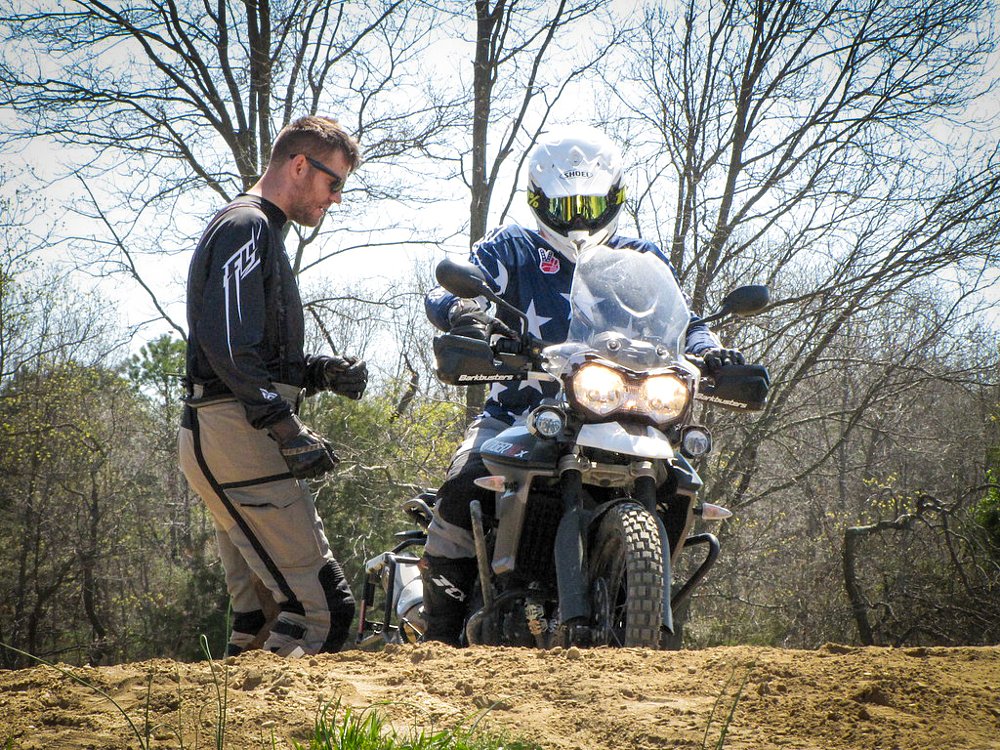
The power delivery works fine off-road, but in certain low-speed situations the gearing is another one of those compromises. I sometimes wish it were geared a bit shorter. The large gas tank can get in the way when standing, and it also means a lot of the weight is up high. This makes the Tiger feel heavier and clumsier off-road than bikes like the F 800 GS or Africa Twin, despite the fact that it is lighter than the competition.
The suspension shows its real weak points off-road once you start to push it. I encountered some really aggressive rocky sections at the AltRider event and the bike just sort of wallowed and lost its way. In Canada, there were some high-speed jumps and ruts that used up all 8.7 inches of the front suspension travel (8.5 inches in the rear). I’ve got the bent front rim to prove it.

When I first rode the Tiger last summer, I cited the crash protection as a potential weak point and it turned out to be the case. Riders looking to really test the limits of the Tiger off-road will want to address some of these issues.
Modifications and service
In the original review, my biggest complaint with this bike, aside from the tires (I installed Mitas E-07s for the review… but we’ll get there) was the crash protection. After buying the bike, I headed back to Bald Eagle State Forest and spent Labor Day weekend riding the rubber off the rims. By the end of the first day, the plastic radiator guard was destroyed, the hand guards had failed, and the crash bars proved to be inadequate to protect the bike.
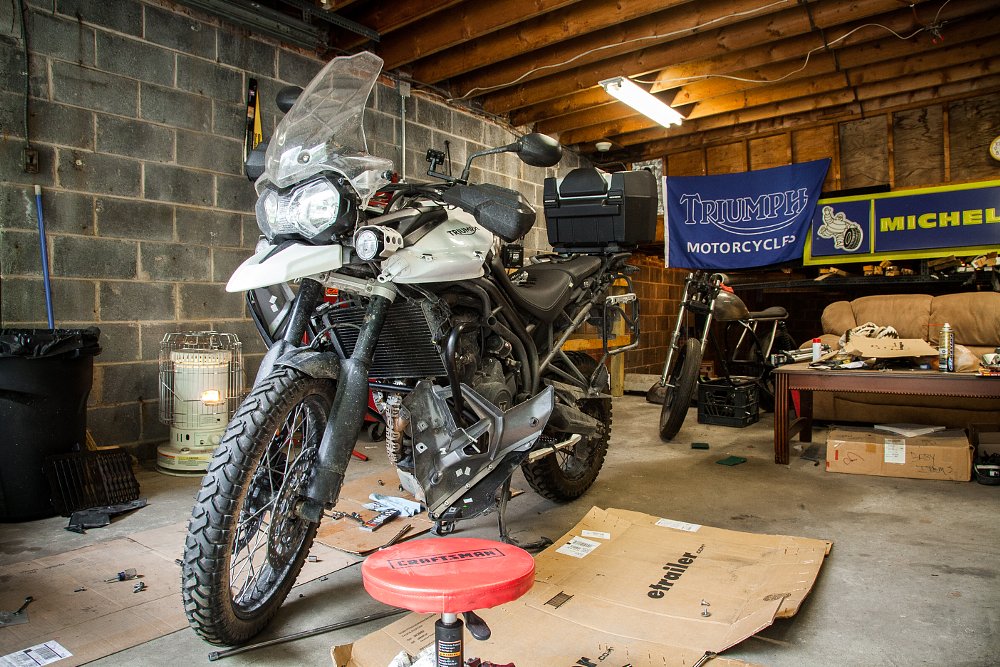
Back in the garage, I installed a set of Barkbusters VPS hand guards, AltRider crash bars, and an AltRider radiator guard. During installation, I noticed that one of the bolts holding the mounting hardware for the factory skid plate had backed itself out and was slowly wearing a hole in the top of the catalytic converter. To get at this I was forced to drop the entire exhaust. While I had the exhaust off I removed all of the mounting bolts and applied thread lock to prevent this from happening again. (I recommend thread lock when installing the crash bars, as well, as I had a mounting bolt back out while racing in Canada.)
The factory skid plate remained intact until this spring when I attended the Conserve the Ride event. Riding the Tiger in more aggressive off-road situations meant harder blows. While I made it through a particular rocky section of trail, the skid plate did not.

So I headed back to the garage. I made additional upgrades prior to tackling the Dacre Challenge in Canada. The Tiger received a new AltRider skid plate, a K&N air filter, and a new set of spark plugs (the filter and plugs were part of the 12,000-mile service). After learning firsthand what a massive pain in the ass it is to get at the air filter on this bike, I wish I had installed a Unifilter Pre-Filter. (One of our readers informed me about this product after Canada, where I sucked up a ton of dust. It’s on my wish list over at Touratech.)

I scrapped the factory tool kit, as it was relatively useless, and assembled one that would actually aid me if I were to get a flat or have a mishap off-road. In order to fit everything into my Giant Loop Klamath Tail Pack, I affixed a pair of tire irons to the Tiger’s sub-frame and stored one spare tube underneath the passenger seat. I was then able to fit an additional tube, all of my tools, and two water bottles into the Klamath. (If you want to cut weight further, you can just carry one 21-inch tube that you can use in the front or the rear in a pinch.)

The first major service for the Tiger comes at 12,000 miles. For riders looking to have this service performed by the dealer, expect to pay around $1,300. This figure will vary, depending on the costs of parts and labor at your particular shop, but this number should give you a ballpark figure of what to expect.
As I was able to address most of the services on the list on my own, I went with an alternative approach. The Tiger requires a one-time camshaft timing adjustment at the 12,000-mile mark to adhere to warranty requirements. So I dropped the Tiger off at Martin Moto in Boyertown, Pennsylvania, and had them adjust the timing and valve clearances and run the required diagnostic scan. I then headed over to the parts department to pick up the spark plugs, air filter, and oil filter needed for the rest of the service.

The total bill came in around $500, including the parts I bought to finish the remaining list of services needed. It took me about four hours in the garage to tackle the rest of the work. I don’t charge myself labor when working on my own machines, so there was no additional cost there.
The 12,000-mile service requires lubing the steering head bearings. My four hours for this job did not include this process. As it is usually a huge pain to get at these bearings, and I can tell mine are already starting to go bad, I am just planning on replacing them over the winter.
I have noticed that the Tiger’s engine, in addition to giving off a ton of heat and being noisy as hell, seems to be drinking oil. I first discovered I was about a quart low shortly before I changed the oil around 5,000 miles (Triumph calls for the oil to be changed every 6,000 miles but I usually do it between 4,000 and 5,000). As I write this, I seem to be about a half quart low after returning from a 300-mile trek this past weekend. I am not the only one. There are three other folks here at RevZilla who have post-2015 Tiger 800s and so far two of those three Tigers are experiencing the same problem. Dustin, our post-production supervisor with a 2016 Tiger XRt, found his bike was two quarts low about 800 miles after his last oil change.
I brought this up with Triumph and they said they would look into it for me. We'll provide an update if more information becomes available.
Tires
Including the stock rubber, I have used three different types of tires with a fourth pair on the way. My goal was to push the limits of the tires as well as the bike itself.
The bike came with Bridgestone Battle Wings installed. These are fine street tires with good wear and good grip on the asphalt. I pulled them off after about 5,000 miles and they looked like they had almost 5,000 miles left to go. For riders who plan to live primarily on the street and who aren’t looking at anything more aggressive than a dirt or fire road for their off-road travel, these will suit you just fine.

In order to get a bit more bite in the dirt, I picked up a set of the Mitas E-07s, which are roughly a 50/50 tire. They take a bit of getting used to initially, due to their steep profile, which causes them to turn in quickly on the street. While they provide great grip off-road, I was even more impressed with their handling on-road. I was able to ride hard enough on the street to scrape the footpeg feelers. Off-road, these tires are best suited for dirt, gravel, and rocks, as the chevron pattern can have a bit of trouble digging in when it finds deep sand and thick mud. You can expect between 7,000 to 9,000 miles out of a rear E-07, depending on use.
The tires currently on the bike are Continental TKC80s, the off-road workhorse of the ADV world. I installed a set of these before attending the Pine Barrens school and after roughly 2,200 miles the rear is beyond shot. While they aren’t the longest lasting tires, they have provided the best off-road grip of the bunch. The biggest problem is that grip begins to fade fast when you get down to the last 30 percent or so of tread. These are for riders who plan on spending the majority of time off-road with their ADV bike.

Next up, I ordered a set of Mitas E-09s, which should be arriving in time for me to start preparing for the Pine Barrens 500 rally in November. From what I have heard from fellow riders, the E-09s provide better off-road bite than the TCK80s and last twice as long. They are also available in a Dakar version with a reinforced sidewall. I am interested to see if they live up to the claims.
The future of the Tiger
I feel like I have come a long way with this bike over the past year but I also think there is a lot more to tackle. I mean this in terms of mods to the bike as well as terrain to traverse with it.
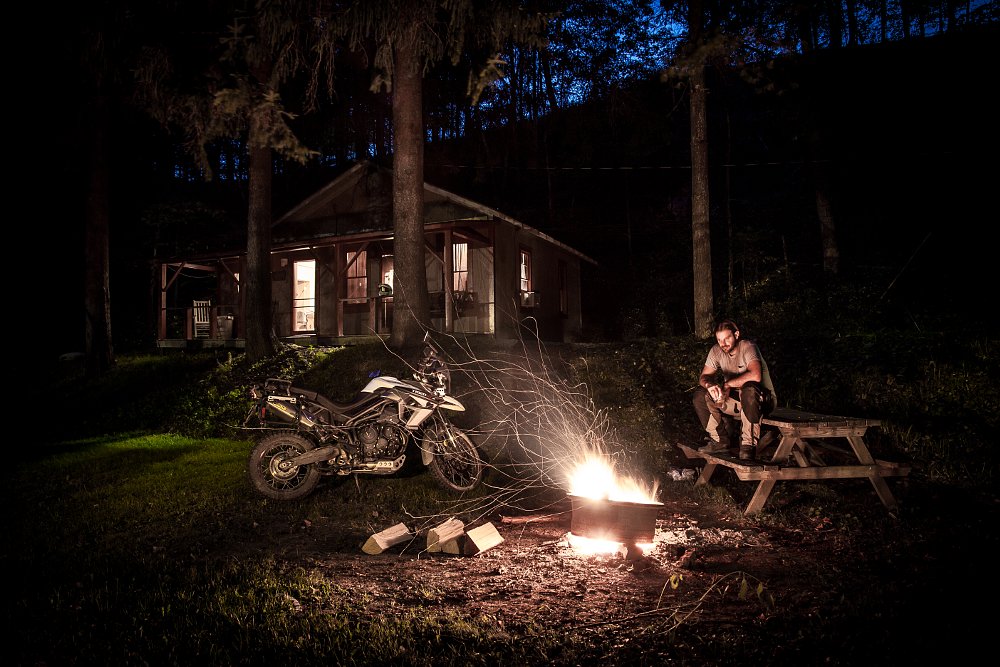
In addition to the new tires and Uni Prefilter, I have some serious upgrades planned for this bike over the winter. I am looking forward to working with Alex and the gang at Konflict Motorsports and Suspension Inc. out in Kent, Washington to get the Tiger’s suspension overhauled. Steve had Konflict build him a suspension for his Tiger and has been raving about it ever since.
As I mentioned earlier, my steering head bearings are starting to go. While the suspension is getting rebuilt, I plan to drop in a set of new All Balls tapered bearings. I will most likely replace the wheel bearings at the same time for good measure.
Along with the bearings, my chain and sprockets are shot and need replacing. I am planning on a new D.I.D chain, as well as dropping two teeth on the front sprocket for better low speed “pop” off-road. By dropping two teeth up front, I shouldn’t have to change chain length and can bump back to stock gearing for longer trips and more comfortable top-end speeds.
The final mod I am considering is swapping out the factory fog lights that came with my bike for a set of the Denali D4 Spot and Flood Hybrid LED lights. The factory fog lights are nearly useless in real off-road rally situations where night riding is required. If I plan on doing a few more of these events in the future, lighting will have to be improved.
I am looking forward to 2017, as there is no shortage of events that ol' Steve Kamrad is trying entice me with.

Conclusion
From my perspective, the Tiger is a compromise. It’s huge, heavy, and wide. A small 300 or 500 would be a lot easier off-road, but those bikes wouldn't be as good on my 2,400-mile trip to Nashville or my two-up rides. The Tiger takes muscle to ride off-road but it’s never left me high and dry. It’s gotten me through some pretty gnarly terrain. Every time I pick it up (after much cursing, grunting, and straining), it always fires right back to life, asking for more. I guess this is why the price never bothered me. From the way I see it, a $13,500 motorcycle should be able to handle $13,500 worth of abuse.
I plan on getting my money's worth.








